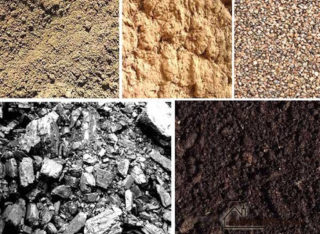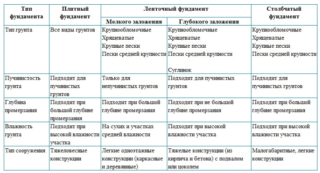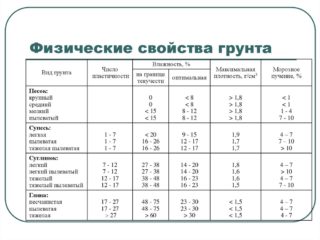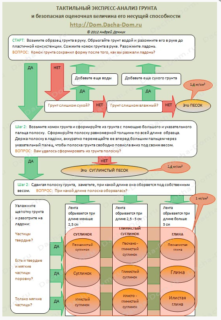Before construction begins, geological surveys are carried out to determine the features and characteristics of the soils. They are necessary to select the optimal type of foundation. The shrinkage processes and the reliability of the base directly depend on the properties of the soil on the site.
- Construction classification of soils
- Soil types by strength
- The main characteristics of soils
- Rocky
- Semi-rocky
- Sandy
- Clayey
- Large clastic
- What do the properties of soils affect when building a foundation?
- Determination of soil properties by eye
- Organoleptic
- Rolling into a ring
- Percentage of different types of soil
Construction classification of soils

Soil in construction is called all loose detrital rocks on which the foundation of the building is arranged.
To standardize the definitions used in the performance of geological surveys, a general standard for building classification of soils has been adopted. He divides soils into classes, types and varieties according to structural relationships, composition and structure.
Initially, the builders used information from SNiP II-15-74. Now, if necessary, refer to GOST 25100-2011.
Soil types by strength
When classifying soil types, there are 2 main groups:
- Rocky - rocks that occur in a continuous massif and have rigid structural connections. These are water-resistant and almost incompressible soils. This type includes limestone, sandstone, granite, basalt and others. In the absence of cracks, they serve as a solid foundation for buildings. The bearing capacity of the fractured layers is reduced.
- Non-rocky - a group of dispersed soils with weakened structural bonds. They consist of mineral particles of various sizes, according to their origin, they are subdivided into sedimentary and artificial. Sedimentary rocks are formed as a result of the destruction and weathering of rocks. Artificial soils are the result of compaction, reclamation or filling. Dispersion soils are cohesive (clay, loam) and incoherent (sand).
Frozen soils are distinguished into a separate class. They are formed as a result of natural or man-made freezing. Frozen foundations are strong due to cryogenic bonds, but the parameter fluctuates due to seasonal changes in air temperature. Only in the permafrost region are such soils stable.
Each class has its own species, types and varieties, due to their origin, structure, composition and properties.
The main characteristics of soils
- Granulometric composition - the percentage of particles of different fractions.
- Water permeability is the ability to allow moisture to pass through the pores.
- Connectivity - the nature and strength of structural bonds that affect the strength of the base.
- Porosity is the ratio of air pores to total volume.
- Plasticity is the degree of deformation with increasing load.
- Shrinkage - a decrease in volume upon drying and compression.
The classification signs of soils will help determine the type of foundation.
Rocky
Tight rocks formed by magmatic eruptions, metamorphic processes, or cementation in sedimentary fragments. They are characterized by low shrinkage, do not lose strength when saturated with water. The disadvantage of rocks is the complexity of the development. Due to the strength of the base, the foundation for the house is laid on the surface.
Semi-rocky
A group of rocks that are inferior to rock analogs in terms of cementation of bonds. They consist of one or more minerals (gypsum, shell limestone, chalk, siltstone). A negative feature of semi-rocky soils is solubility and softening when interacting with water. Subsidence and a decrease in the bearing capacity are taken into account when choosing the depth of the foundation of the building.
Sandy
Clayey
A type of bonded soils, consisting of fine silt particles of silicates. Depending on the amount of moisture, the soil is solid, plastic or fluid consistency. Clay compresses under load, the speed of its compaction is low, so the settlement of buildings is delayed. In a solid state, clayey soil is a solid base. When water enters the pores under the influence of negative temperatures, heaving processes occur.
Large clastic
Fragments of rocks, among which parts larger than 2 mm prevail. An example is gravel, crushed stone, pebbles. The strength of the soil depends on the nature of the debris. Rocky parts of magmatic origin are highly durable. The density of the soil is related to the uniformity of the placement of the fragments. It is characterized by low compressibility and good water permeability.
The properties of loam and sandy loam depend on the percentage of sand and clay particles.
What do the properties of soils affect when building a foundation?

The strength and durability of the building being erected depends on the composition and characteristics of the underlying rock. Insufficient bearing capacity, heaving or a tendency to subsidence leads to cracks, distortions and other problems with the integrity of the walls of the house and the foundation.
Also, the method of land excavation and the choice of equipment depend on the geological features of the site. The excavation is carried out manually, by machine or by explosive methods. Depending on the density of the soil in private construction, shovels, picks, crowbars, jackhammers are used. The density of the soil affects the formation of the walls and slopes of the excavation. In coarse soils, vertical walls up to 2 m deep are permissible without reinforcement, and only 1 m in sandy soils.
Strong soils (rocky, coarse-grained, sandy) are suitable for the construction of houses of various storeys and do not have special requirements for the foundation. On weak soils, with a high level of groundwater, columnar, pile foundations or a monolithic reinforced concrete slab are arranged. For clayey soil prone to heaving, it is necessary to lay a buried strip foundation below the freezing point.
Determination of soil properties by eye
To take samples, you will need to dig a hole equal to the depth of the future foundation. Several simple methods will help to determine the characteristics of the soil:
Organoleptic
The easiest way to know the composition of the soil is to use your sight and tactile senses.
- Sand - no lumps are formed, the particles are homogeneous, solid, well visible. The size of the grains of sand can also be assessed visually. In gravelly sand, they are up to 5 mm, in coarse sand - up to 2 mm, in medium - about 1 mm.
- Sandy loam - feels like flour due to dusty particles; when squeezed, it quickly crumbles.
- Loam - grains of sand are weakly felt, wet lumps hold well.
- Clay - a fine yellowish powder, when wet, sticks to the hands, and hard lumps are formed.
The type of soil is determined by its appearance: clay and loam are hard pieces that crumble when struck with a hammer, sandy loam crumbles when squeezed by hand, sand does not form lumps.
Rolling into a ring
The method is also simple - you need to moisten a handful of soil, try to roll a tourniquet, and make a ring out of it. The flagellum will not work out of the sand, but from the sandy loam it will quickly fall apart. If the cord rolls but cracks when bent, it is loam. It is easy to make a ring from plastic clay.
Percentage of different types of soil
You will need a clean 1 liter jar. Up to half of it is covered with the studied soil, then it is poured to the top with water. After settling, which takes from several hours to 2-3 days, the height of the soil layers is measured and the percentage is calculated. The bottom layer will be made of sand, then sandy loam with dusty particles, the upper part will be clay.
Most of the areas suitable for construction are sedimentary rocks. Knowing their properties, the designer can choose the best way to build the foundation.











